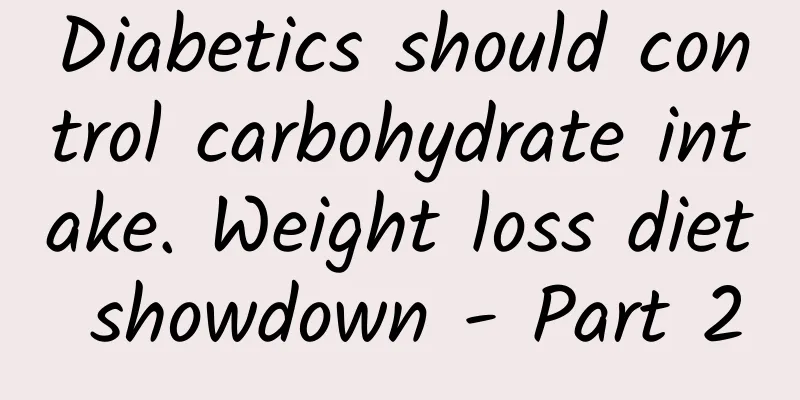Diabetics should control carbohydrate intake. Weight loss diet showdown - Part 2

|
There is another large dietary study worth mentioning, which is a study jointly published in the New England Journal of Medicine (NEJM) by Harvard University and the Pennington Biomedical Research Center (a well-known obesity research center in the United States), "Comparing the effects of different proportions of fat, protein and carbohydrate diets for weight loss." This study involved a larger number of subjects and lasted for two years. Its purpose was to compare the weight loss effects of different compositions of dietary calorie sources. The subjects were divided into four groups: LFAP (low-fat group), LFHP (low-fat and high-protein group), HFAP (high-fat group), and HFHP (high-fat and high-protein group). The diets of these groups differed in the proportions of carbohydrates, fats, and proteins (as shown in the figure below). In addition to the different diets, all subjects were advised to adopt a low GI diet and restrict their calorie intake (750 calories less than the estimated calorie intake for ideal body weight), all of which were weight loss diets that restricted total daily calories. Each subject was also given a menu and shopping list designed in two-week units, allowing them to easily follow the course. I don't think this study is as well designed as Stanford's "A TO Z Weight Loss Study". The main reason is that the four groups in this Harvard study all adopted the same diet, which was designed based on the food substitution principles proposed by the American Diabetes Association (ADA). Therefore, the food choices of different groups are actually similar, but the portion sizes are different. For example, the breakfast contents of the subjects in different groups were as follows: Because of this design, the spirit and theory of various diets cannot be seen in this study, which is a pity. Moreover, the subjects received much more intervention than the "A TO Z Weight Loss Study". Until the end of the study, the subjects had to attend classes every month to ensure the implementation of the weight loss plan. The Harvard study concluded that calorie-restricted diets are equally effective in reducing weight, regardless of the ratio of carbohydrates, fats and proteins included. If we combine many of the data in this study with the data from the "A TO Z Weight Loss Study," we can come to some interesting conclusions. According to previous studies on weight loss diets, six months is the time point when weight loss effects are most significant. So we compiled the data on the proportion of calorie sources in the subjects' diets at six months from the two studies into the above figure, where the blue part is the proportion of carbohydrates, the red part is fat, and the green part is protein. The first interesting point is the percentage of calories from protein in the diet. Regardless of the diet recommendations, it can be observed that all subjects consumed an average of about 20% protein, even the Akin diet, which is known as a meat-eating diet. We can draw a conclusion here that the total amount of protein a normal person consumes in their diet does not increase or decrease much, and the body seems to control the total protein intake . It is indeed very similar and I have never heard of anyone becoming addicted to eating meat. The second interesting point is that regardless of whether or not calorie intake was restricted, the average total calorie intake of all subjects was around 1,600 calories per day , even for diets that did not restrict calorie intake, such as the Akin diet or the Ornish diet. Nearly half of the calories in the Ajin diet group came from fat, but the total calories were not more. Does this mean that fat can really provide more satiety? Calorie-restricted diets do lead to weight loss, as observed in both studies (although with varying degrees of success) . But this raises a question. Remember that Taubes, the author of "Facing the Truth about Obesity," mentioned that eating less will not help you lose weight. So why did these subjects who reduced calories lose weight? In fact, this can be explained. If we look closely at the proportion of carbohydrates in the above chart (the blue part), we can find that most diets (except the Akin diet) have the highest proportion of carbohydrates (about 50%) . So when the subjects reduced their calorie intake, the biggest reduction was actually in carbohydrate intake . For example, if you reduce your calorie intake by 800 calories, about 50% of which are carbohydrates, that means you have reduced your carbohydrate intake by 100 grams (800×50%/4). This does not contradict Taubes' conclusion that eating less carbohydrates is the main reason for losing weight. The above chart is a comparison of the calorie ratios recommended by each diet in the "A TO Z Weight Loss Study" and the actual calorie ratios consumed by the subjects at six months. You can see: •The Akin diet recommends that carbohydrates be kept below 50 grams, which is less than 15% of daily calories, but in reality the subjects can only control it to around 30%. It is difficult to achieve the extremely low carbohydrate intake required by the Akin diet. •The Ornish diet recommends keeping fat to less than 10% of daily calories, which is incredibly low. In fact, the subjects probably couldn't do it, and at best they could only control it below 30%, which also means that it is actually very difficult to achieve the extremely low fat recommended by the Ornish diet. • The obstacle of the interval diet is that it recommends protein intake to reach 30% of daily calories. We have mentioned before that, on average, protein accounts for about 20% of total dietary calories, and it is difficult to increase it to 30% (this requires eating a lot of lean meat without fat). It seems that there is a gap between the theory and reality of various diets, so perhaps we shouldn't be so extreme when looking at diets. Like the Akin diet, I don't think it's healthy because it recommends using a lot of nutritional supplements. In fact, the Akin diet group in the "A TO Z Weight Loss Study" did not supplement so many nutrients, nor did they consume such a small amount of carbohydrates, but the results seemed ideal. If you are interested, there is a follow-up micronutrient analysis study of the A TO Z weight loss study published in the American Journal of Clinical Nutrition: "Micronutrient Quality Report of the A TO Z Weight Loss Study", which contains a more detailed micronutrient analysis. Theoretically, if carbohydrate intake is limited to less than 50 grams per day, the body will switch to fat as the main energy source and enter ketosis. In fact, most of the subjects in the Akin diet group were unable to reduce carbohydrates to such a low level, so they did not enter ketosis. At the same time, the Akin diet has always given people the stereotype of eating a lot of meat and consuming a lot of protein, but in fact it was observed that the protein intake of the subjects was less than 25%, which is no different from a normal diet. The accusation that the Akin diet would cause dyslipidemia was also dropped in this study, and it seems that the Akin diet is not that bad after all. A conclusion can be drawn from these two studies that reducing carbohydrate intake is most effective for weight loss without restricting calorie intake. It should be noted, however, that the subjects of these two studies were mainly people without diabetes. So even though it seems that the Akin diet, which advocates carbohydrate restriction, stands out in the research, it is still debatable whether it is suitable for people with diabetes. But I can imagine that learning to control carbohydrate intake and understanding the carbohydrate portions of food will become increasingly important skills for people with diabetes. This article comes from: Diabetes Life Guide References: 1. Gardner, Christopher D., et al. “Comparison of the Atkins, Zone, Ornish, and LEARN diets for change in weight and related risk factors among overweight premenopausal women: the A TO Z Weight Loss Study: a randomized trial.” Jama 297.9 (2007): 969-977. 2. Sacks, Frank M., et al. “Comparison of weight-loss diets with different compositions of fat, protein, and carbohydrates.” New England Journal of Medicine 360.9 (2009): 859-873. 3. Gardner, Christopher D., et al. “Micronutrient quality of weight-loss diets that focus on macronutrients: results from the A TO Z study.” The American journal of clinical nutrition 92.2 (2010): 304-312. ※For more information, please see "Diabetes Life Guide" |
<<: The Akin Diet vs. the Ornish Diet… A Big Weight Loss Diet Showdown - Part 1
>>: Are fruit seeds more nutritious? 6 Fruit Seeds That Can Cause Poisoning
Recommend
What should be paid attention to after uterine fibroid surgery? How should patients with uterine fibroids take care of their diet?
Some women may not be able to get good results wi...
Four common examination methods for uterine fibroids
The examination method of uterine fibroids plays ...
How to prevent habitual miscarriage in early pregnancy? You need to pay attention to these aspects
Nowadays, more and more young couples or lovers h...
Pituitary tumors often cause amenorrhea
Pituitary tumors account for about 10% of all int...
What should women pay attention to in post-abortion care
What should women pay attention to when taking ca...
How can women detect the symptoms of early ectopic pregnancy after pregnancy?
Ectopic pregnancy will cause the fetus to not hav...
Clinical manifestations of hyperprolactinemia
Hyperprolactinemia is a very common disease, whic...
Can a small amount of pelvic effusion heal itself? How to treat pelvic effusion?
Nowadays, many women live in a fast-paced environ...
What are the examination methods for pelvic peritonitis?
When you have a disease, the best way is to make ...
The trend of younger abortions needs to be reversed
On May 19, Professor Chen Yijun of the Chinese Ac...
Detailed introduction to some typical symptoms of cervical hypertrophy
For a common skin disease like cervical hypertrop...
Constipation accelerates aging! 7 tips to say goodbye to constipation
There are many reasons why people usually have a ...
What measures can be taken to detect irregular menstruation?
Most gynecological diseases are cured faster the ...
What complications can uterine fibroids cause?
There are many complications of uterine fibroids,...
1 to 2 weeks after menstruation to lose weight and eat whole grains to eliminate stool
Having a slim figure is something women dream of ...









